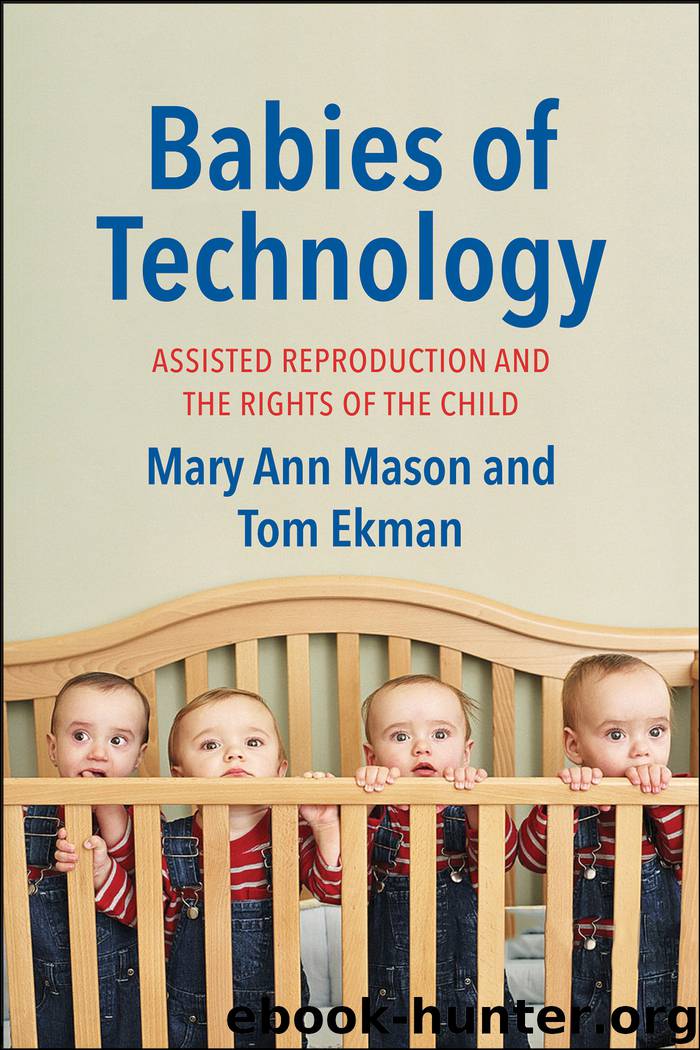Babies of Technology by Mary Ann Mason

Author:Mary Ann Mason
Language: eng
Format: epub
Publisher: Yale University Press
Published: 2017-04-06T04:00:00+00:00
CHAPTER 5
Wombs
Rudy Rupak, the founder of a medical tourism company in California called Planet Hospital, has never been shy about self-promotion. Over the last decade, he has broadcast the fact that his company has helped Americans head overseas for affordable tummy tucks and hip replacements. After he expanded his business to include surrogacy in India for Western couples grappling with infertility—and then in Thailand, and last year, Mexico—he publicly took credit for the global spread of surrogacy. Today, Rupak is in involuntary bankruptcy proceedings, under investigation by the Federal Bureau of Investigation, and pursued by dozens of furious clients from around the world who accuse him of taking their money and dashing their dreams of starting a family.1
The surrogate mother option, sometimes called “rent-a-womb” by its detractors, has caused far more legal difficulties and provoked greater emotional concern than sperm or egg donation. In the United States, not all states allow surrogacy, but those that do (such as California) support a huge industry that caters to both domestic and international clients. U.S. surrogates offer two major advantages: any baby born in the United States is automatically a U.S. citizen, and the states that support surrogacy also welcome gay couples. Internationally, surrogacy is often banned, or limited to heterosexual couples who are infertile.
Traditional surrogacy, in which the surrogate mother is also the biological mother, may be the oldest form of assisted reproduction. Genesis tells of Abraham’s servant Haga bearing a child to be raised by his genetic father, Abraham, and his infertile wife Sarah. His name was Ishmael.
The modern version of surrogacy, which became available once in vitro fertilization was possible, is gestational surrogacy. The surrogate is implanted with an embryo and carries the child to term. It is most often the embryo created by the couple who retained the surrogate, but in some cases, the egg is a donor egg. The child will have no genetic relationship to the surrogate. The genetic mother may be either the “intentional” mother who arranged the deal, or an anonymous egg donor.
There are a growing number of gay male couples whose surrogate carries an embryo composed of an egg from a donor and sperm from one of the male partners. Sometimes, these couples mix their sperm so that either of them could be the possible father.
It is not easy to dismiss the rights of surrogate mothers. The acts of pregnancy and childbirth are central to our emotional understanding of motherhood. In fact, until the Calvert v. Johnson case in California in the early 1990s, the definition of mother was still the “one who gives birth.” The gendered nature of parenthood has been thrust into our public discourse, provoking feminists to openly cross swords. Some decry the potentially exploitive and patriarchal nature of the practice of surrogacy. According to these feminists, rich couples that “rent” the wombs of poor women are engaging in another form of prostitution. Other feminists protest that this stance is misguided paternalism—the state once again attempting to regulate what a woman does with her body.
Download
This site does not store any files on its server. We only index and link to content provided by other sites. Please contact the content providers to delete copyright contents if any and email us, we'll remove relevant links or contents immediately.
Future Crimes by Marc Goodman(3002)
American Kingpin by Nick Bilton(2972)
The Meaning of the Library by unknow(2069)
Inside the Middle East by Avi Melamed(1940)
On Tyranny by Timothy Snyder(1859)
Why Nations Fail: The Origins of Power, Prosperity, and Poverty by Daron Acemoglu & James Robinson(1787)
Living Silence in Burma by Christina Fink(1729)
Putin's Labyrinth(1656)
The Mastermind by Evan Ratliff(1591)
Think Like a Rocket Scientist by Ozan Varol(1396)
Law: A Very Short Introduction by Raymond Wacks(1383)
The Smartest Kids in the World by Amanda Ripley(1368)
Leadership by Doris Kearns Goodwin(1349)
The Rule of Law by Bingham Tom(1318)
A Dirty War by Anna Politkovskaya(1314)
It's Our Turn to Eat by Michela Wrong(1301)
Philosophy of law a very short introduction by Raymond Wacks(1297)
Social Media Law in a Nutshell by Ryan Garcia & Thaddeus A Hoffmeister(1249)
Civil Procedure (Aspen Casebooks) by Stephen C. Yeazell(1175)
